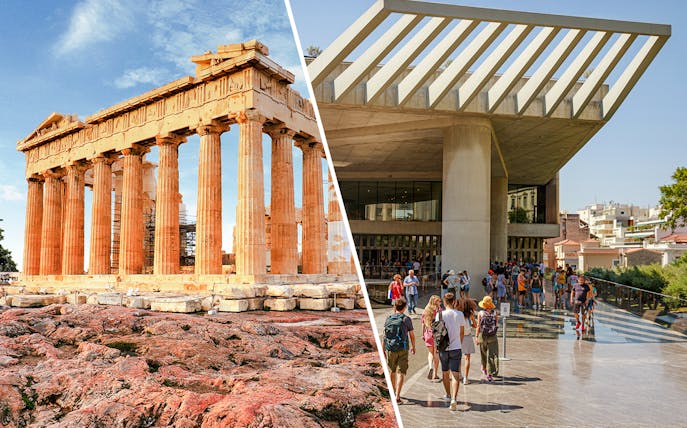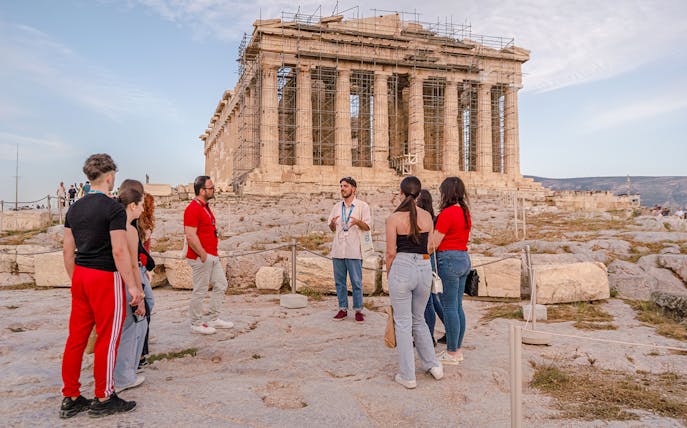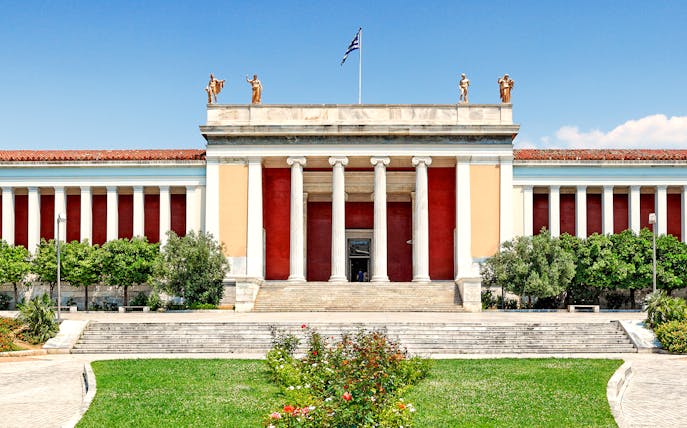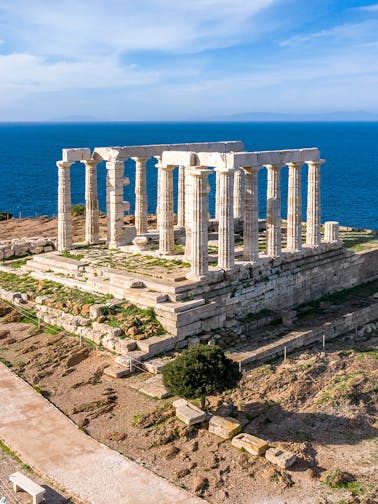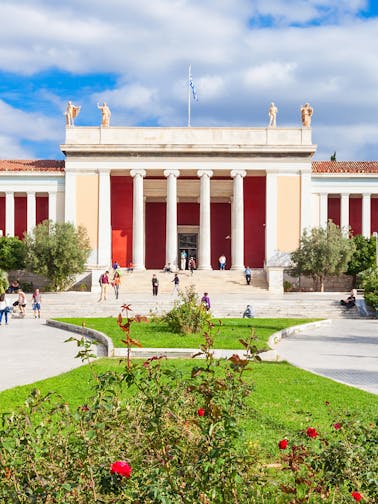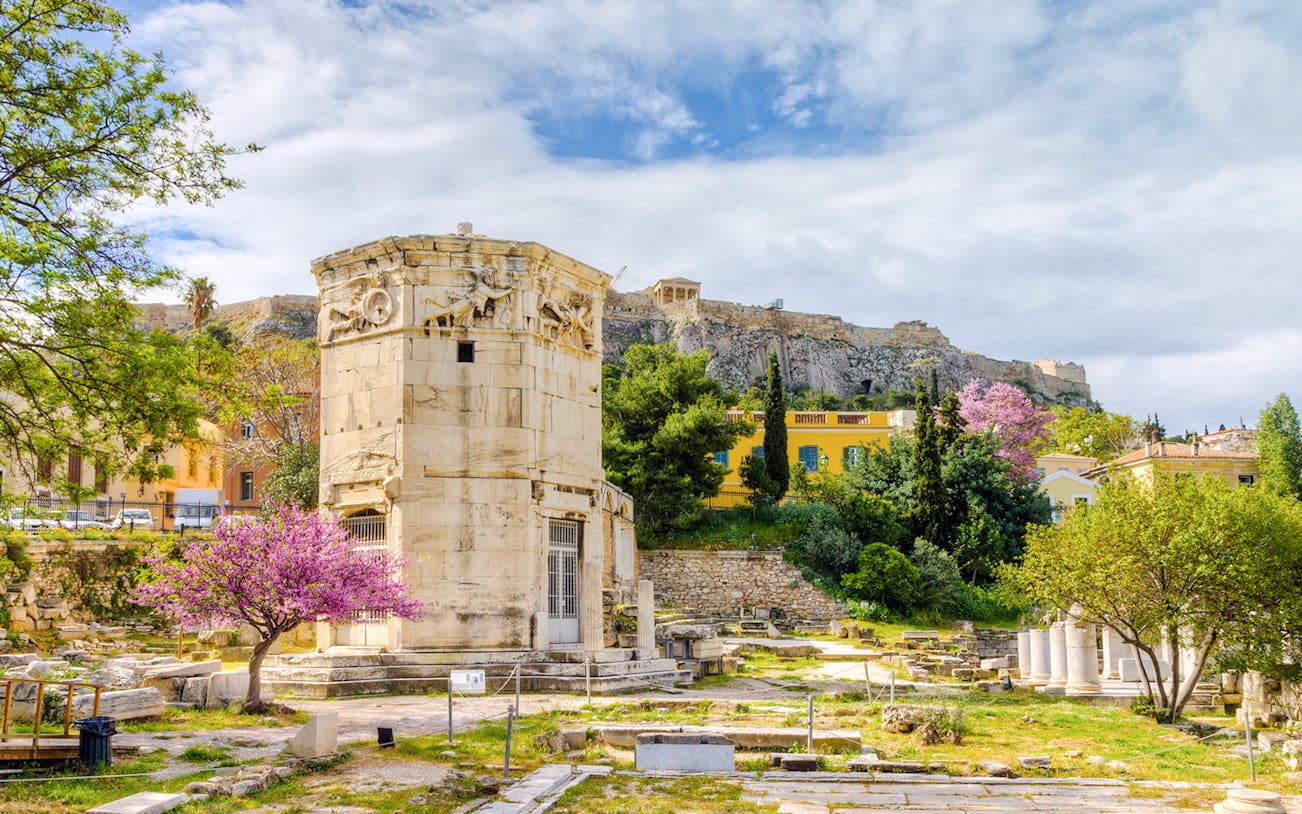

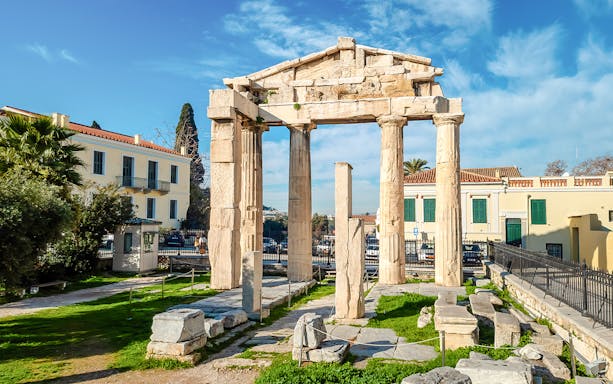
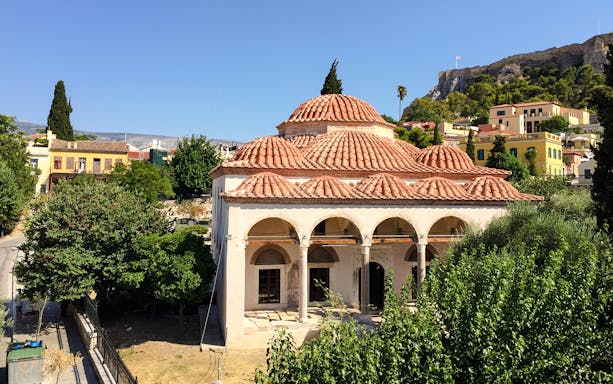
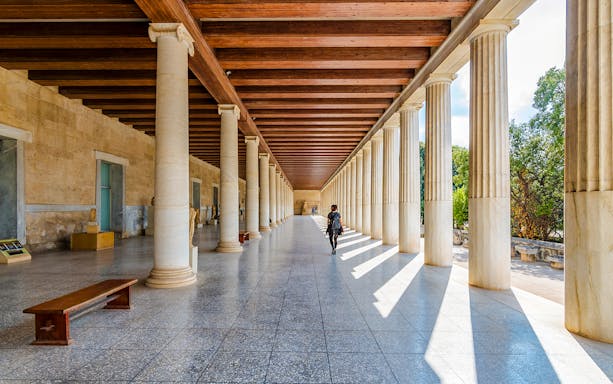
Explore at your pace
Audio guide
-
Just steps apart, explore two of Athens’ greatest marketplaces with one ticket and trace centuries of history, culture, and daily life side by side.
-
In the Ancient Agora, stand before the Temple of Hephaestus, one of Greece’s best-preserved temples, and admire the Stoa of Attalos, now home to a museum filled with artifacts of Athenian life.
-
At the Bouleuterion, hear how 500 citizens drafted laws and how figures like Aristides the Just and Pericles shaped the world’s first democracy.
-
In the Roman Agora, pass through the marble Gate of Athena Archegetis and marvel at the Tower of the Winds, the clever clock that told time and weather.
-
Your audio guide brings the ruins to life with stories of lively trade, heated debates, and cultural change—from the rise of Greek democracy to Roman power and Ottoman rule.
-
-
Entry to the Ancient Agora
-
Entry to the Roman Agora
-
Access to the Temple of Hephaestus
-
Access to the Museum of the Ancient Agora in the Stoa of Attalos
-
3-hour self-guided audio tour of both sites on your smartphone (Android and iOS)
-
Audio guide available in English, Spanish, German, French, and Italian (based on option selected)
-
Offline content (text, audio narration, and maps)
-
-
Hotel pick-up and drop-off
-
Transfers
-
Live guide
-
Headphones
-
Food and beverages
-
Personal expenses
-
These tickets can't be cancelled. However, they can be rescheduled up to 24 hours before the experience begins.
Unlock the stories of Athens’ two great marketplaces with a single combo ticket to the Roman and Ancient Agoras, complete with two self-guided audio tours on your smartphone.
Getting started
Once you receive your ticket by email, download the app and the two audio tours before your visit. Begin your adventure at the entrance to the Roman Agora (Epaminonda 6–22), just a short 230-meter walk from Monastiraki metro station along Areos Street.
Athens under Roman rule
Explore the Roman Agora, Athens’ bustling marketplace under Roman rule, where marble gates, ingenious timekeepers, and lively shops reveal the city’s blend of Greek tradition and Roman innovation.
-
Athena’s marble getaway: Your journey begins at the Gate of Athena Archegetis, a marble gateway donated by Julius Caesar and Augustus. Hear how traders, philosophers, and citizens once passed through its towering columns, a passage that reflected both Roman influence and devotion to Athens’ patron goddess.
-
Where the winds tell time: Next, head to the Tower of the Winds, an ingenious octagonal clock that combined sundials, a water clock, and carved figures of the eight wind gods, an age-old blend of art, science, and mythology.
-
Water, trade, and everyday life: Walking further, you’ll encounter the fountain house, the Vespasianae (public latrines), and the outlines of ancient shops. Your audio guide brings these modest ruins alive with tales of bustling trade, gossip, and the social interactions that defined daily life under Roman rule.
-
Athens through the ages: The tour concludes at the Mosque of the Conqueror, a 15th-century Ottoman addition built atop the ruins of the Roman marketplace. Once a place of worship and later repurposed as a museum and storehouse, it embodies the many transformations Athens has undergone—from ancient Greek democracy to Roman rule, Byzantine influence, and finally Ottoman conquest.
The birthplace of democracy
Afterward, walk to the Ancient Agora on Adrianou Street, a lively stretch near Monastiraki Square and Thissio station. Here you’ll come across temples, stoas, and assembly halls that once carried the voices of debates, philosophies, and decisions that shaped the course of Western history.
-
The heart of Classical Athens: Stop by the Temple of Hephaestus, one of the best-preserved Doric temples in Greece. Dedicated to the god of fire and craftsmanship, it stood watch over workshops where artisans forged bronze and marble creations for the city. Along its walls, you can still make out carved scenes of the hero Theseus battling legendary creatures like the Minotaur and the Centaurs.
-
Where democracy took shape: At the Bouleuterion, 500 citizens were chosen by lot to draft Athens’ laws, debate new policies, and post decrees for all to see. It was here that Aristides earned the title ‘the Just’ for his honesty, and Pericles delivered speeches that propelled Athens into its Golden Age of art, philosophy, and empire.
-
Inside the Stoa of Attalos: Now housing the Museum of the Ancient Agora, this reconstructed colonnade displays artifacts that reveal both the ingenuity and the harshness of Athenian justice. Ostraka, pottery shards once used to vote unpopular leaders into exile, sit alongside clever devices that randomized jury selection, showing how Athenians balanced fairness with severity in their pursuit of democracy.
-
Voices of the people: Finally, climb the Pnyx, the great stone platform where citizens once assembled to hear orators and cast their votes on war, peace, and policy. Nearby, the Prison of Socrates recalls the philosopher’s trial and execution, sparking reflection on freedom of speech, civic duty, and the city that both nurtured and condemned its greatest thinker.
Your tour concludes at the Stoa of Attalos, where history, artifacts, and stories converge, leaving you with a vivid sense of how Athens forged ideas that still resonate across the world today.
A complete journey through Athens’ legacy
Together, these tours create a seamless narrative: the Roman Agora shows you how Athens adapted under new rulers, while the Ancient Agora takes you back to its Golden Age. With the Acropolis rising above both sites, and stories of gods, philosophers, and everyday citizens guiding you at every step, you’ll leave with a deeper understanding of how Athens became one of history’s most influential cities.
-
What to bring
-
Wear comfortable, durable shoes, as much of the ground is uneven and can become dusty and slippery in dry weather.
-
Carry a refillable water bottle—there is a fountain for refills by the Stoa of Attalos, which is particularly useful in the hot summer months.
-
Bring a hat, sunscreen, and extra water, since shade is scarce around the ruins and the sun can be intense.
-
Ensure your smartphone is fully charged so it lasts for the entire audio experience.
-
Use your own headphones for the best listening experience.
What’s not allowed
-
Flash photography and tripods are prohibited on-site. Professional filming or photography requires prior authorization from the Ministry, and staff may intervene if you attempt to set up equipment without a permit.
-
Flying drones is not allowed over archaeological sites without special clearance, so please do not attempt to use one here.
-
Pets are not permitted within the sites, except for certified service animals.
-
Do not pick up, move, or take stones, pottery fragments, or other remains, as antiquities are strictly protected by Greek law.
Accessibility
-
Both the Roman and Ancient Agora are only partially wheelchair accessible. At the Roman Agora, visitors with reduced mobility can enter through the main entrance on Dioskouron Street, while at the Ancient Agora, there is an accessible entrance via the Apostolou Pavlou gate near the Temple of Hephaestus.
-
Inside both sites, much of the terrain is uneven, with gravel paths, slopes, and ancient paving, which makes full wheelchair access very limited. If you use the main entrance to the Ancient Agora at Adrianou 24, it is best to have a companion to help navigate, and you may also contact site staff at +30 210 3214824 or +30 210 3210180 for assistance.
-
Each site provides inclusive features for visually impaired visitors, including Braille information boards and tactile maps.
-
The museums at both Agoras are fully accessible for visitors with reduced mobility and wheelchair users. The Museum of the Ancient Agora in the Stoa of Attalos also offers an accessible restroom and tactile site plans and brochures in Braille (Greek and English).
Additional information
-
Each booking is valid for one device; please make separate reservations if you plan to use more than one.
-
You can enter the archaeological sites only during your selected time slot. Your ticket is valid from 15 minutes before until 15 minutes after your chosen slot.
-
Arrive at least 30 minutes early to allow time for security and entry. Note that entry is permitted up to 20 minutes before closing time.
-
After booking, you’ll receive an email with instructions to access and download your audio tour; be sure to also check your spam folder.
-
Download your tickets and audio tour in advance over Wi-Fi, as the mobile signal at the sites may be weak.
-
Due to ongoing construction works, the main entrance of the Ancient Agora is temporarily closed. Please use the temporary entrance on Apostolou Pavlou Street, near Akamantos Street.
-
You’ll need an Android smartphone (version 5.0 or later) or an iOS device (version 15.0 or later). The audio tour is not compatible with Windows Phones, iPhone 6/6 Plus or earlier, iPod Touch 6th generation or earlier, iPad 4th generation or earlier, iPad Air 1st generation, or iPad Mini 3rd generation or earlier.
-
Make sure your phone has 200 to 300 MB of free storage space to download the audio tour.
-
Head to the entrance on Epaminonda 6-22, Athina 105 55 to begin your Roman Agora experience. The tour ends at the Mosque of the Conqueror, after which you continue to the Ancient Agora at 24 Adrianou Street. That tour concludes inside the site at the Stoa of Attalos, a short walk from the entrance.
-
The course of your visit may change, and certain restrictions may apply. Please follow all on-site guidelines at all times.
Concession eligibility
-
EU citizens under 25, including students, enjoy free admission year-round with a valid ID or passport, but must queue at the ticket office to collect a zero-value pass.
-
Non-EU citizens under 25 are entitled to discounted rates during the peak season (April to October) with a valid ID, and must also queue at the ticket office.
-
Children under 5 years old enter free of charge.
-
-
Your voucher will be emailed to you instantly.
-
Please arrive at the redemption point 15 mins before the scheduled time of your visit to avoid any delays.
-
Display the voucher on your mobile phone with a valid photo ID at the redemption point.
Ticket redemption point
-
Show your ticket at Epaminonda 6.
-
Address: Epaminonda 6, Athina 105 55, Greece.
-
Similar experiences you'd love
Top things to do in Athens
Nearby cities to explore

